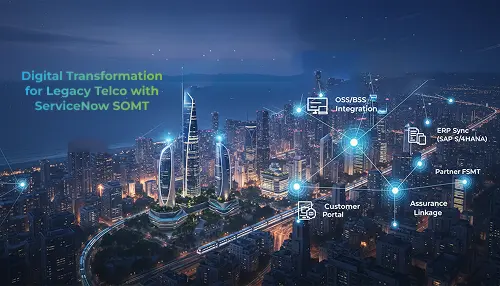End-to-End Digital Transformation for a Legacy Telco with ServiceNow SOMT

↓ 66%
Average Activation Cycle
↑ 34%
Net Promoter Score (NPS)
↑ 25%
Supplier SLA Compliance
Introduction
The Client Overview
The client, a Tier-1 telecom operator, offers broadband, enterprise connectivity, and mobility services. Their growth was being constrained by :-
- Outdated OSS/BSS systems require manual patches for every product launch.
- Disconnected ERP systems, leading to misaligned billing and financial leakage.
- Supplier silos, where a lack of digital collaboration delayed last-mile provisioning.
As the CIO from the client side summarized:
“We didn’t have an order problem. We had a visibility and accountability problem. The lack of integration meant nobody—from customer to supplier—had a single source of truth.”
Challenges
1. Order Fallout and Manual Interventions
- 40% enterprise orders failed during provisioning, often due to mismatched service parameters across OSS, BSS, and ERP.
- Reprocessing required manual intervention, inflating OPEX.
- No early-warning system for fallout; issues surfaced only after customer complaints.
2. Fragmented Customer Experience
- No real-time order tracking for customers; support calls were the only visibility.
- CSAs had to toggle between 6+ systems to answer simple status queries.
- Disconnected catalog meant upselling opportunities were lost.
3. Supplier and Partner Silos
- Suppliers acknowledged orders manually, with 48–72 hour delays.
- Inventory mismatches between supplier systems and the telco’s ERP often caused last-minute order cancellations.
- SLA tracking with vendors was non-digital and reactive.
4. Post-Fulfillment Assurance Gap
- No linkage between order activation and service assurance workflows.
- Faults raised post-delivery were treated as fresh incidents, not tied to the originating order.
- This created data silos between fulfillment and assurance, impacting Mean Time to Repair (MTTR).
Solution
Stream 1 – Order-to-Activation Automation
- Integration with OSS/BSS: Leveraged ServiceNow IntegrationHub to connect SOMT with OSS provisioning systems, ensuring orders were validated at the capture stage.
- ERP Alignment: Configured connectors between SOMT and ERP (SAP ECC → S/4HANA migration-ready), enabling financial validation before activation.
- Event-Driven Orchestration: Built a rules engine to detect data mismatches (address errors, unavailable inventory) and either auto-correct or route to specialized queues.
- Billing Synchronization: Automated handoff from activation to ERP billing, eliminating manual reconciliation.
Stream 2 – Customer Experience (CX) Unification
- Self-Service Portal: Customers could now log in, track order progress, and raise complaints tied to their order ID.
- CSA Empowerment: Virtual Agent gave CSAs instant summaries of order history, assurance tickets, and delivery status in a single screen view.
- Proactive Communication: Catalog integration allowed SOMT to trigger contextual offers (e.g., enterprise WiFi for broadband orders) during activation.
Stream 3 – Partner & Supplier Fulfillment Automation
- API-Level Supplier Integration: Connected supplier inventory and delivery systems directly to SOMT, ensuring real-time availability updates.
- FSMT Extension: Partner field engineers were onboarded into ServiceNow FSMT for last-mile provisioning tasks (e.g., fiber trenching, CPE installation).
- Digital SLA Tracking: Dashboards monitored supplier performance across metrics like acknowledgment time, delivery completion, and defect rates.
Stream 4 – Assurance Integration (Order-to-Delivery-to-Support)
- Closed-Loop Fulfillment-to-Assurance: Linked SOMT with ServiceNow ITSM and Assurance modules. Any incident raised post-delivery was tied back to the originating order.
- Root Cause Analysis (RCA): Enabled CSAs and NOC teams to trace faults to specific fulfillment stages (e.g., supplier router delay → activation defect → outage).
- Real-Time Alerts: Customers received automated updates when assurance tickets were raised or resolved, restoring transparency.
The Results
| Metric | Baseline | Post-LMTEQ Implementation | Improvement |
|---|---|---|---|
| Order Fallout | 40% | 8% | ↓ 80% |
| Average Activation Cycle | 12 days | 4 days | ↓ 66% |
| ERP Billing Errors | 18% | 2% | ↓ 89% |
| CSA Average Handling Time | 12 mins | 7 mins | ↓ 40% |
| First Call Resolution | 58% | 88% | ↑ 30% |
| Net Promoter Score (NPS) | +12 | +46 | ↑ +34 points |
| Supplier SLA Compliance | 68% | 93% | ↑ 25% |
| MTTR (Assurance Ops) | 22 hrs | 9 hrs | ↓ 59% |
Value
- CIO – Modernized architecture integrating ERP, OSS/BSS, and SOMT ensures scalability and readiness for 5G rollouts.
- COO – SLA adherence and automated fallout handling lowered operational costs while improving delivery KPIs.
- CMO – CX portal + proactive offers directly boosted upsell and retention rates.
- CFO – ERP alignment reduced billing errors and leakage, improving margin discipline.
Why LMTEQ
- Telecom Expertise – Pre-built playbooks for order-to-activation and assurance workflows.
- Integration Mastery – Proven expertise in ERP, OSS/BSS, and supplier system integrations using ServiceNow IntegrationHub.
- Custom Engineering – Built auto-fallout handling engines and real-time SLA dashboards tailored for telecom.
- Holistic Approach – Unlike siloed system integrators, LMTEQ delivered end-to-end visibility of order, customer, partner, and assurance.
Conclusion
By unifying order-to-activation automation, customer experience portals, partner collaboration, and assurance operations, our team delivered more than a ServiceNow implementation; we engineered a business transformation. The client now operates on a single pane of glass for telecom operations, aligning IT, finance, and CX with measurable business outcomes.
Looking to eliminate order fallout, integrate ERP with fulfillment, and deliver customer transparency at scale? Partner with LMTEQ to build your telecom of the future, today.
As an AI-powered transformation partner, we help businesses unlock potential with ServiceNow to achieve faster, high-quality outcomes.